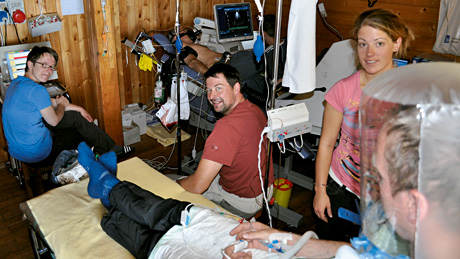No Appetite in the Alps

Headaches, fever, and shortness of breath: The first reports of altitude sickness among climbers date back more than 2,000 years. Now we know that the condition results from the lower air pressure at high altitude, and not – as is often believed – because the air contains less oxygen.
“Altitude sickness can strike from around 2,500 meters above sea level, especially if you’re climbing fast,” explains Professor Max Gassmann, Director of the Institute of Veterinary Physiology at the University of Zurich, and head of the Zurich Center for Integrative Human Physiology (ZIHP). Besides headaches, the symptoms include exhaustion, loss of appetite, sleeplessness, and swollen hands and feet. Mountaineers who ignore the warning signs and continue climbing can also suffer fluid retention in the lungs or brain. If untreated, edemas of this sort can rapidly become life-threatening.
Gassmann’s group is looking into how molecules, cells, tissue and the organism as a whole respond to a lack of oxygen. “It’s not just at high altitudes that a lack of oxygen can become a problem. It can also be an issue if people lose blood after an accident or a difficult birth,” explains Max Gassmann. His colleague Thomas Lutz, also a professor of veterinary physiology at the University of Zurich, is focusing on questions around loss of appetite at high altitude.
“We’ve known about the phenomenon for a long time, but so far the causes have remained more or less obscure,” says Lutz, who like Gassmann has an affinity for the mountains. Loss of appetite doesn’t just happen on mountain peaks. It can also affect people with certain respiratory diseases at normal altitude. Since the body usually resorts to the same mechanisms in an attempt to restore physiological balance, the researchers anticipate that their findings about what happens to the body at high altitude will also help treat patients at normal elevation more effectively.
Acute shortage of oxygen
This has prompted the two veterinary physiologists from Zurich to team up with nutritionists and specialists in intensive-care medicine, pneumology and gastroenterology at University Hospital Zurich to run an unusual project spanning normal altitude and the Margherita Hut at 4,559 meters above sea level. The things they’re investigating include the eating behavior of mountaineers after a rapid ascent, and changes in the uptake and metabolism of the trace element iron, which plays a key role in the binding of oxygen.
Normally mountaineers are advised to climb slowly – above 2,500 meters not more than 300 to 500 meters a day. But for this project it was different. The healthy mountaineers who were recruited as volunteers for the study were examined after a rapid ascent that led to a severe oxygen deficit. Participants accepted the risk of getting altitude sickness, albeit under medical supervision.

Damaged mucous membranes
“Our original hypothesis was that people eat less at high altitude because more appetite-suppressing hormones are secreted,” says Thomas Lutz. But this assumption turned out to be wrong. While it’s true that the climbers ate less after the rapid ascent to 4,559 meters, the effect wasn’t due to a change in the levels of these hormones. Biopsies from the stomach and duodenum showed that at altitude the stomach lining displayed more injuries, similar to ulcers.
“Experiments with rats in altitude chambers conducted in Zurich also suggest that the stomach empties more slowly at altitude,” adds Thomas Lutz. This mechanism is also part of the appetite regulation system. But examinations of human subjects in the Margherita Hut haven’t yielded any firm answers so far.
Natural laboratory
At high altitude people breathe more quickly to ensure the body gets enough oxygen. Another adaptation that can be observed is increased production of red blood vessels – although this only happens after a number of days at high elevation. Production of these so-called erythrocytes is regulated by a hormone called erythropoietin, better known by its abbreviation, EPO. Erythrocytes bind oxygen with the help of iron.
If more erythrocytes are formed in the high mountains than at normal elevation, this should mean that the iron metabolism has to adapt at altitude as well – another of the Zurich team’s hypotheses, which in this case has turned out to be correct. The results show that the uptake of iron in the intestine and transportation of the trace element increase substantially after only a short time at 4,559 meters. This is an important prerequisite for increased production of erythrocytes, which could then compensate for the lack of oxygen.
Margherita Hut is a kind of natural laboratory for Gassmann and Lutz. There they can look into the effects of a lack of oxygen before people get altitude sickness. Their findings will in turn lead to insights into things like chronic pulmonary diseases. An inadequate supply of oxygen to the organs and cells plays a key role in the final stages of many life-threatening diseases. For this reason the altitude researchers are also hoping for new insights into how people suffering from these extremely serious diseases could be treated more effectively on a routine basis in hospital.